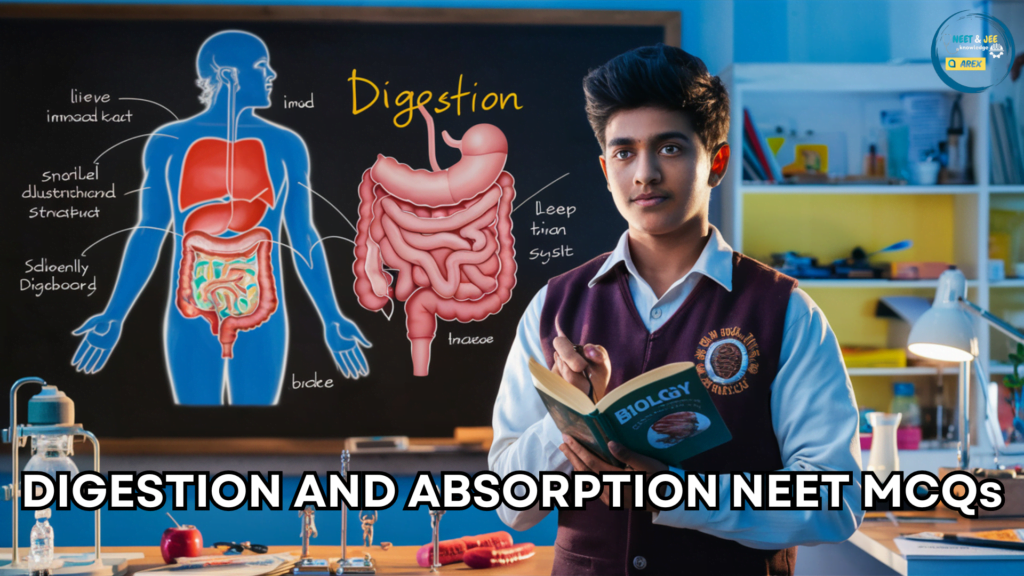
DIGESTION AND ABSORPTION MCQ FOR NEET BIOLOGY
Digestion and absorption are important processes in the human body. Digestion starts in the mouth, where food is broken down by chewing and saliva. This process continues in the stomach, where strong acids and enzymes break down proteins. The food, now called chyme, moves into the small intestine. Here, digestive juices from the pancreas and bile from the liver further break down the nutrients.
Absorption happens mainly in the small intestine. Tiny hair-like structures called villi help absorb nutrients into the blood. Simple sugars, amino acids and fatty acids pass through the intestinal walls into the bloodstream. Water and minerals are also absorbed. The remaining undigested food moves into the large intestine, where water is absorbed and waste is formed. This waste is eventually excreted from the body. Understanding these processes is important for NEET students, as they are key topics in human physiology.
| NEET 2025 Exam Important Links | |
|---|---|
| NEET 2025 Updated Syllabus | NEET Eligibility Criteria 2025 |
| Biology Preparation | Chemistry NEET Preparation |
| NEET Preparation tips for 2025 | NEET Result 2024 |
DIGESTION AND ABSORPTION MCQ FOR NEET

Select the option which correctly identifies A, B, C, D and E.
Thus, they have 2 incisors, 1 canine, 0 premolars and 2 molars. Therefore, the baby boy would not have premolars.
It is transferred to the pharynx and then to oesophagus by deglutition. Finally, it reaches into the stomach for chemical digestion, which is carried out by various enzymes.
Enhance your preparation with Arexiq’s Mock Test Series where we provide solutions to various MCQs like we provide in this post “Digestion and Absorption MCQ for NEET”. Our expert teachers explain the concepts thoroughly, making it easy for you to understand. We offer many types of questions ensuring a clear grasp of concepts.
FAQs
- What is digestion?
Answer. Digestion is the process of breaking down food into smaller, absorbable components like simple sugars, amino acids, and fatty acids.
- Where does digestion begin?
Answer.Digestion begins in the mouth, where food is chewed and mixed with saliva.
- What role does the stomach play in digestion?
Answer. The stomach secretes acids and enzymes that break down proteins into smaller peptides and amino acids.
- What are the main digestive enzymes and their functions?
Answer. Amylase (breaks down carbohydrates), pepsin (breaks down proteins in the stomach), lipase (breaks down fats in the small intestine).
- How does the small intestine aid in digestion and absorption?
Answer. The small intestine is where most digestion and absorption occur, aided by enzymes from the pancreas and bile from the liver.
- What are villi and what is their function?
Answer. Villi are tiny hair-like structures in the small intestine that increase the surface area for nutrient absorption.
- What happens to nutrients after they are absorbed?
Answer. Absorbed nutrients enter the bloodstream and are transported to various cells in the body for energy, growth, and repair.
- What is the role of bile in digestion?
Answer. Bile, produced by the liver and stored in the gallbladder, helps emulsify fats, making them easier to digest by lipase.
- How is water absorbed in the digestive system?
Answer. Water is primarily absorbed in the small and large intestines.
- What happens to undigested food?
Answer. Undigested food moves into the large intestine, where water is absorbed, and the remaining material is formed into feces to be excreted.
- What is the importance of digestion and absorption in maintaining health?
Answer. Proper digestion and absorption are essential for providing the body with the necessary nutrients for energy, growth, and repair.
- What is the significance of understanding digestion and absorption for NEET?Answer. Knowledge of digestion and absorption is crucial for NEET as it forms a fundamental part of human physiology, which is extensively tested in the exam.


